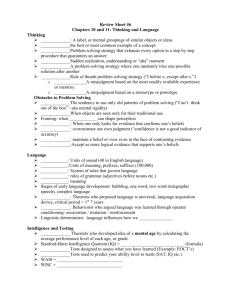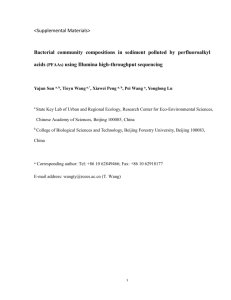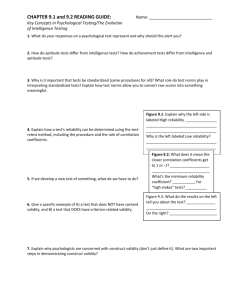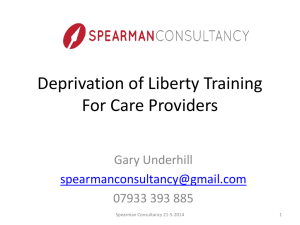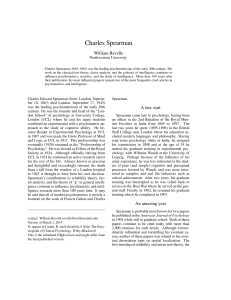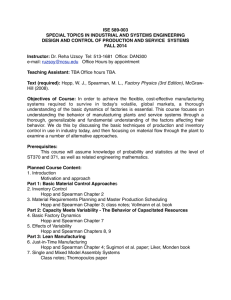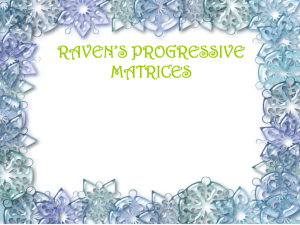The Classical Theory of Mental Tests
advertisement
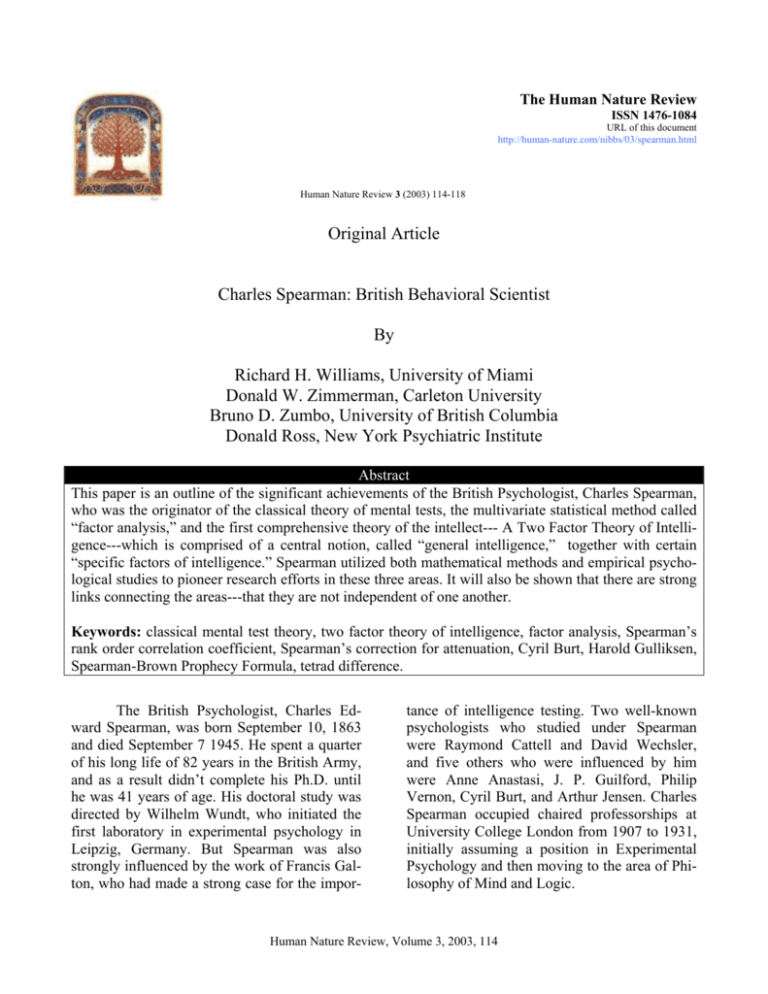
The Human Nature Review ISSN 1476-1084 URL of this document http://human-nature.com/nibbs/03/spearman.html Human Nature Review 3 (2003) 114-118 Original Article Charles Spearman: British Behavioral Scientist By Richard H. Williams, University of Miami Donald W. Zimmerman, Carleton University Bruno D. Zumbo, University of British Columbia Donald Ross, New York Psychiatric Institute Abstract This paper is an outline of the significant achievements of the British Psychologist, Charles Spearman, who was the originator of the classical theory of mental tests, the multivariate statistical method called “factor analysis,” and the first comprehensive theory of the intellect--- A Two Factor Theory of Intelligence---which is comprised of a central notion, called “general intelligence,” together with certain “specific factors of intelligence.” Spearman utilized both mathematical methods and empirical psychological studies to pioneer research efforts in these three areas. It will also be shown that there are strong links connecting the areas---that they are not independent of one another. Keywords: classical mental test theory, two factor theory of intelligence, factor analysis, Spearman’s rank order correlation coefficient, Spearman’s correction for attenuation, Cyril Burt, Harold Gulliksen, Spearman-Brown Prophecy Formula, tetrad difference. The British Psychologist, Charles Edward Spearman, was born September 10, 1863 and died September 7 1945. He spent a quarter of his long life of 82 years in the British Army, and as a result didn’t complete his Ph.D. until he was 41 years of age. His doctoral study was directed by Wilhelm Wundt, who initiated the first laboratory in experimental psychology in Leipzig, Germany. But Spearman was also strongly influenced by the work of Francis Galton, who had made a strong case for the impor- tance of intelligence testing. Two well-known psychologists who studied under Spearman were Raymond Cattell and David Wechsler, and five others who were influenced by him were Anne Anastasi, J. P. Guilford, Philip Vernon, Cyril Burt, and Arthur Jensen. Charles Spearman occupied chaired professorships at University College London from 1907 to 1931, initially assuming a position in Experimental Psychology and then moving to the area of Philosophy of Mind and Logic. Human Nature Review, Volume 3, 2003, 114 Human Nature Review 3 (2003) 114-118 The purpose of this paper is to describe Spearman’s contributions to factor analysis, theories of intelligence, and mental test theory, and to provide evidence that he was an innovative force and pioneer in all three areas. Additionally, logical links will be made available to connect the three areas. In other words, the three contributions are not independent of one another. The Classical Theory of Mental Tests Most psychologists and many other behavioral and social scientists view Harold Gulliksen’s classic book, Theory of Mental Tests (1950), as the definitive treatment of the classical theory of mental tests.. Of course, when it was published in 1950 it was the only comprehensive, mathematical development of psychological test scores. Since then there have been a number of test theory models. See Crocker and Algina’s Introduction to Classical and Modern Test Theory (1986) for a discussion of the state of psychometrics. In the classical theory, a starting point is X = T + E, where X is observed score, T is true score, and E is error score. The investigator would like to know the true measurement, but, unfortunately, errors of measurement obscure the true values. Therefore, one objective of measurement procedures is to minimize errors of measurement. Important topics in test theory are the estimation of test reliability and test validity. Reliability has to do with consistency of measurement, whereas validity focuses on whether the test or measuring device actually measures what it purports to measure. Incidentally, the term “reliability” was introduced by Spearman. In mental test theory these notions are treated mathematically. For example, the variances of the components of tests scores are additive, i.e., Var[X] = Var[T] + Var[E]. Then reliability is defined as the ratio of true score variance to observed score variance, or Var[T]/Var[X]. On page 1 of Gulliksen’s text he says: “Nearly all the basic formulas that are particularly useful in test theory are found in Spearman’s early papers.” (1904a, 1904b). One such formula, which was jointly discovered by William Brown, shows the influence of test length on test reliability. It is called the SpearmanBrown Prophecy Formula. In investigating test validity the test scores to be validated are called X and they are validated against a criterion called Y. For example, X might be SAT verbal scores and Y could be grade point average in freshman year in college. Then the correlation between X and Y is a validity coefficient. Spearman derived an equation which displays the effects of altering the length of both the test and the criterion on validity. Then the validity of a perfect test for predicting a perfect criterion is called Spearman’s Correction for Attenuation. It yields an estimate of the true score correlation. Conditions under which this formula is useful have been presented by Zimmerman and Williams (1997). For further information on Spearman’s contributions to test theory see “Spearman’s Test Score Model” (Ng, 1974) and “Charles Spearman’s Contributions to Test Theory” (Levy, 1995). Factor Analysis “In general, this approach involves obtaining a set of n measurements on the same examinees, computing an nxn correlation matrix between these measurements, and then using factor analytic techniques to identify some reduced number of underlying variables (called factors) which account for variation in the original set of n variables.” (Crocker & Algina, 1986, p. 232) In the well-known factor-analytic textbook and treatise by Harry Harman, Modern Factor Analysis (1976), the author makes the following statement on page 3: “The origin of factor analysis is generally ascribed to Charles Spearman.” “Spearman invented factor analysis….” (Bartholomew, 1995, p. 211) “Charles Edward Spearman is known for two major contributions to behavioral science: a methodological one---which we now call factor analysis; and a substantive one---the development of a rational basis for determining Human Nature Review, Volume 3, 2003, 115 Human Nature Review 3 (2003) 114-118 the concept of general intelligence and for validating intelligence testing.” (Cattell, 1968, p. 108) A.D. Lovie and P. Lovie (1993, p. 308) provided a critical analysis of the correspondence between Charles Spearman and Cyril Burt in an effort to determine which of the two scientists should be viewed as the originator of factor analysis. Their conclusion was: “From a detailed examination of this correspondence, we argue that Spearman’s contribution to Burt’s paper [1909] was both central and crucial, and confirms Spearman’s priority of factor analytic methods, as they were understood at the time.” Factor analyses are applied to matrices of intercorrelations among observed score variables. But since it is of greater interest to describe relations among the underlying or latent variables, why not apply Spearman’s correction to the observed score correlations, thereby generating a matrix of estimated true score correlations, and then factor analyze the latter matrix? This seemed promising because the true score correlations would be larger and hence would account for a greater proportion of the variance. Errors of measurement tend to depress or attenuate ordinary correlation coefficients. One reason why this wasn’t widely done is that some controversy surrounded the correction. For example, it sometimes yielded values larger than 1.00. (Zimmerman, & Williams, 1997). Notice that here we have provided a link between mental test theory and factor analysis. “Three milestones mark Spearman’s contribution to factor analysis and they span almost half a century. His ‘[General Intelligence] objectively determined and measured’(Spearman, 1904a) marks the introduction of factor analysis. His book The Abilities of Man, their Nature and Measurement (Spearman, 1927) brings together the fruits of two decades of research into a coherent whole. The third milestone….is the book Human Ability [which was] completed by Wynn Jones and published six years after Spearman’s death. (Spearman & Jones, 1951)” (Bartholomew, 1995, p. 211) A Two-Factor Theory of Intelligence Charles Spearman created the first psychometric theory of intelligence, a two-factor theory, and published it in the American Journal of Psychology in 1904. His work in factor analysis paved the way for the application of statistical methods to the study of human intelligence. “Setting up a matrix of correlations among the test scores and academic ranks, Spearman noticed that they could be arranged and analyzed in a special way, ‘hierarchically,’ to show that all the variables measured just one ‘factor’ in common, but to different degrees. From this discovery, Spearman developed what he called….the ‘two factor’ theory of intelligence, whereby each test of a set is regarded as measuring one ‘general’ factor in common with all the other tests and, in addition, a ‘specific’ factor that is unique to that test.” (Carroll, 1982) “The high point for Spearman’s system was undoubtedly reached in 1927 with the publication of The Abilities of Man, which presented the accumulated experimental and philosophical evidence supporting a theory of human intelligence with the general factor as its ruling , but not sole, principle.” (Lovie & Lovie, 1996, p. 82) It may be helpful to describe the components of Spearman’s theory in terms of cognitive performance. “Spearman’s two-factor theory of intelligence---or of ‘g’ as he preferred to symbolize the discovered general factor--states that any cognitive performance is a function of two ‘factors’---the general ability common to most cognitive performances and an ability specific to a given test.” (Cattell, 1968, p. 109) It should be noted that the nature of a theory of intelligence can strongly dictate the way in which intelligence tests are constructed. Some of the well-known intelligence tests are designed to measure Spearman’s “g.” It is said that Raven’s Progressive Matrices, which is a non-verbal, cross-cultural test of intelligence is Human Nature Review, Volume 3, 2003, 116 Human Nature Review 3 (2003) 114-118 one of the best measures of Spearman’s ‘g.’ John Raven worked closely with Charles Spearman in constructing this test. Since it might “slip through the cracks,” we should mention that Spearman developed a rank order correlation coefficient that is widely used. It can be applied to find the monotonic relation between two sets of ranks, whereas the usual Pearson product-moment correlation coefficient is used to analyze linear relations among variables. The Spearman rho calculates a Pearson correlation coefficient between two sets of observations which consist of integer ranks. One could say that the Pearson formula is general whereas the Spearman formula is special, i.e., the original formula applied to a special case. This uncomplicated procedure has been obscured somewhat in the statistical literature by formulas intended to simplify calculations. In a similar way, the short-cut equations for the point biserial and phi coefficients are also special cases of the Pearson. The “clever” bit on Charles Spearman’s part was realizing that by ranking data initially, a non-parametric form of coefficient could be achieved, even when employing the Pearson formula thereafter. Dr. Jan Strelau, the Associate Editor of the European Psychologist, was interviewed in the year 2000, and one question he was asked was: What were the three to four most significant developments in scientific or professional psychology in the 20th century? His second selection was as follows: “One can hardly imagine the development of theories of intelligence without recognizing the empirically based finding of Charles E. Spearman for whom intelligence is regarded as the well-known g factor. There is no doubt that Spearman’s g construct was the catalyst for most intelligence theories (both in supportive and contradictory versions) developed over the past century. And g became one of the major concepts underlying the construction of many intelligence tests, without which professional psychology would be strongly mutilated..” (Tele-Interviews, 2000) Spearman utilized the method of tetrad differences in analyzing intelligence test data to support his two-factor theory of intelligence. A tetrad difference is actually the determinant of a 2x2 matrix. If it is zero the data are consistent with the notion of a single general factor. The American psychologist L. L. Thurstone was in violent opposition to Spearman’s theory and generalized the British psychologist’s criterion of tetrad differences to examination of higher order determinants as a criterion for more than one common factor. Thurstone’s theory of intelligence postulates seven primary mental abilities and he and his co-workers constructed seven tests to correspond to these factors. Others developed hierarchical theories that retained “g” in the structure. One of these was the Canadian psychologist Philip Vernon and the other was the American psychologist Raymond Cattell. In Cattell’s theory ‘g’ is at the top of the hierarchy and it becomes partitioned into fluid and crystallized intelligence, with Spearman’s specific ability factors at the bottom of the hierarchy. Matrix formulation and the advent of high speed computers have greatly facilitated the development of factor analysis. It is now common to distinguish between exploratory and confirmatory factor analysis with the latter more theory bound and hence used to test hypotheses. Concluding Comments Applications involving all three areas of Spearman’s research contributions are readily conceivable. His intelligence theory could be used to guide construction of a set of ability tests and then the test scores factor analyzed. Mental test theory would be employed to investigate the psychometric properties of the ability tests. Factor analysis itself is a way of studying validity and a second approach is to correlate the test scores with external criteria. A method favored by Spearman to estimate reliability is to correlate scores on parallel forms of a test. Correspondence to: Richard H. Williams, Ph.D., Professor of Educational and Psycho- Human Nature Review, Volume 3, 2003, 117 Human Nature Review 3 (2003) 114-118 logical Studies, University of Coral Gables, FL 33124, USA. rwill4515@aol.com. Miami Email: Notes 1. Portions of this paper were presented at the Ninety-Fourth Annual Convention of the Southern Society for Philosophy and Psychology in Nashville, Tennessee in March, 2002 by Professor Richard H. Williams. 2. We would like to thank Dr. Paul Barrett for his helpful evaluative comments. . References Bartholomew, D.J. (1995). Spearman and the origin and development of test theory. British Journal of Mathematical and Statistical Psychology, 48, 211-220. Burt, C. (1909). Experimental tests of general intelligence. British Journal of Psychology, 3, 94-177. Carroll, J.B. (1982). The measurement of intelligence. In R.J. Sternberg, Ed., Handbook of Human Intelligence, pp.29-120. Cambridge: Cambridge University Press. Cattell, R.B. (1968). Spearman, C. E. In International Encyclopedia of the Social Sciences, 15, D. E. Sills, Ed., pp. 108-111, New York: Macmillan. Crocker, L., & Algina, J. (1986), Introduction to classical & modern test theory. New York: Harcourt Brace Jovanovich. Gulliksen, H. (1950). Theory of mental tests. New York: Wiley. Harman, H. H. (1976). Modern factor analysis (3rd ed., rev.). Chicago: University of Chicago Press. Levy, P. (1995). Charles Spearman’s contributions to test theory. British Journal of Mathematical and Statistical Psychology, 48, 221-235. Lovie, A. D., & Lovie P. (1993). Charles Spearman, Cyril Burt, and the origins of factor analysis. Journal of the History of the Behavioral Sciences, 29, 308-321 Lovie, P. & Lovie, A. D. (1996). Charles Edward Spearman, F.R.S. Notes and Records of the Royal Society of London, 50, 1-14. Ng, K. T. (1974). Spearman’s test score model: A restatement. Educational and Psychological Measurement, 34, 487-498. Spearman, C. E. (1904a). ‘General intelligence’ objectively determined and measured. American Journal of Psychology, 5, 201-293. Spearman, C. E. (1904b). Proof and measurement of association between two things. American Journal of Psychology, 15, 72-101. Spearman, C. E. (1927). The abilities of man, their nature and measurement. New York: Macmillan. Spearman, C. E., & Jones, L. W. (1951). Human abilities. London: Macmillan. Tele Interviews. (2000). Interview of Jan Strelan. European Psychologist, vol. 5. (http://www.hhpub.com/journals/ep/200 0/abstv5i2-28.html). Zimmerman, D.W., & Williams, R.H. (1997). Properties of the Spearman correction for attenuation for normal and realistic non-normal distributions. Applied Psychological Measurement, 21, 253-270. Human Nature Review, Volume 3, 2003, 118
